How Raytheon Is Helping Deconflict Civilian Airspace for Drone Flight
In conjunction with the FAA, Raytheon is working to enable autonomous navigation and safe, unobstructed flight in civilian airspace.
The U.S. military and its civilian partners in the commercial airline community are working with the Federal Aviation Administration (FAA) to organize the increasingly cluttered airspace caused by the rapid arrival of thousands of drones flooding the commercial market. How can they be governed? What will the standards be? Is there a way to organize and deconflict the increasingly crowded airspace?
Raytheon Intelligence & Space (RI&S), which already engineers many Air Traffic Control Systems across the United States, is working on a new radar technology capable of quickly deconflicting cluttered airspace using radar and non-line-of-sight networking. This Air Traffic Management System, Raytheon developers explained, uses advanced radar, artificial intelligence-enabled computing, and cloud technology to align separate streams of information. The overall effort is aimed at creating previously non-existent technical standards sufficient to construct new parameters for governing the airspace.
The concept for unmanned systems now being pursued by RI&S and the FAA to create new standards seems to represent the maturation of the open architecture approach to software upgrades and common standards anticipated years ago. All of this led to the emergence of a technological system that enabled multiple drones and unmanned systems to perform a wide range of key functions at specific altitudes and speeds, and thereby deconflict the airspace.
“There is a lot that goes into the communications possibilities. There is a lot of cyber protection to make sure that the information that they are using is secure and has a high level of integrity,” Kip Spurio, technical director of Air Traffic Systems at Raytheon Intelligence & Space, told The National Interest in an interview.
Cloud computing, Spurio explained, can integrate large pools of otherwise disparate sets of information and make data available to drones flying a specified route at a certain time and altitude such that it is fully deconflicted with other drones.
The intent of RI&S’s cloud-enabled end-to-end system is to enable drones to “transit the airspace with all the capabilities we're going to provide, allowing them to operate beyond visual line of sight, unobstructed,” Spurio described.
“We're taking certain capabilities and wrapping them in containers and putting them in the cloud or developing other ones from scratch. And we're doing all this to show the FAA that this can be done, you know, rapidly and, safely and securely,” Spurio said.
Much of RI&S’s system involves software engineering and upgrades, analyzed in large measure through advanced modeling and simulation. The fundamental task essentially pertains to data flow, data management, data analysis, and data transmission in an organized, deconflicted pattern to enable autonomous navigation and safe, unobstructed flight.
“We've created a modeling and simulation environment to develop this, using tools that we at Raytheon have in place. We've created a simulation model for our capability,” Spurio added.
The emerging technologies, if applied effectively, can help create new technical standards, interfaces, and software applications so that large amounts of lower-altitude drones can operate successfully in congested environments.
“It is a process that is not well defined with the FAA right now. We are working with our various teammates to jump through hoops as the FAA learns how they want to do this. They don’t have long-established standards for how to do it yet,” Spurio said.
Kris Osborn is the defense editor for the National Interest. Osborn previously served at the Pentagon as a Highly Qualified Expert with the Office of the Assistant Secretary of the Army—Acquisition, Logistics & Technology. Osborn has also worked as an anchor and on-air military specialist at national TV networks. He has appeared as a guest military expert on Fox News, MSNBC, The Military Channel, and The History Channel. He also has a Master's Degree in Comparative Literature from Columbia University.
Image: Reuters.

